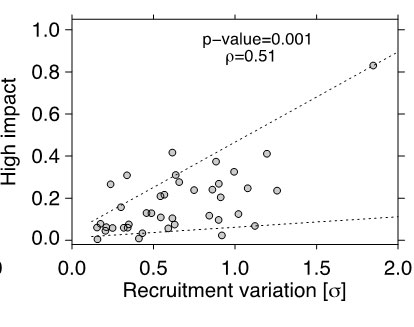Early life stages of fish, that are the egg, larvae, and juvenile stages, typically experience high mortality. However, certain events can lead to even higher mortality (termed mass mortality events). Such dramatic events can be caused by for example heat waves, disease outbreaks, or human-caused disasters such as marine oil spills. To understand how these events particularly affecting early life stages can result in population-level effects, we investigated the effects of a single year-class reduction in 40 different fish species (Langangen et al. 2023). We applied two scenarios, where the early life stages experienced 50% or 99 % increased mortality in a single year. The population dynamics for these scenarios with elevated mortality were compared with non-perturbed scenarios (Fig.1) to record the reduction in population biomass.
These tests show a range of potential outcomes and depend on the characteristics of the species studied (Fig.1). In particular, we find that long-lived species with a high degree of compensatory density dependence (slowed population growth rate at high densities and numerical increase of the population at low densities) in early survival were generally more resilient to mass mortality events. In addition, species with a high degree of inter-annual variation in recruitment can have a very high impact in some years (Fig.2).

These relationships allow for predictions of the potential impacts of early-life mass mortality in a range of fish species. Such relationships can help us better predict which fish species can potentially be susceptible to a high impact of human-caused mass mortality. Such predictions can be useful in the face of the rising occurrence of mass mortality events across the globe.
References:
Langangen Ø., Ohlberger J., Stige L.C., Patin R., Buttay L., Stenseth N.C., Ono K. & Durant J.M. (2023). Effects of early life mass mortality events on fish populations. Fish and Fisheries 24(1): 176–186. doi:10.1111/faf.12718.

Log in to comment
Not UiO or Feide account?
Create a WebID account to comment